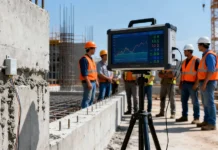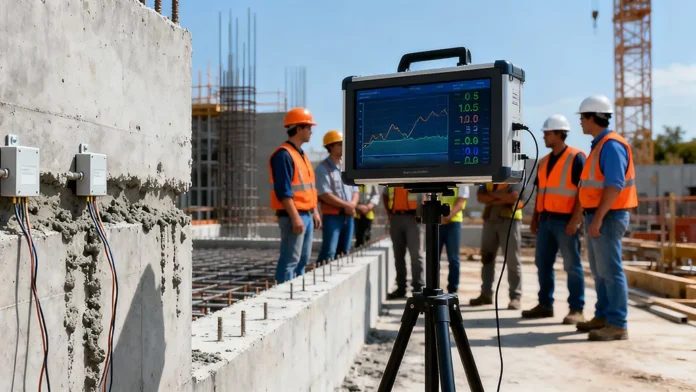The construction industry stands at the threshold of a digital revolution, and at its core lies an innovation reshaping how infrastructure is monitored and maintained. Smart concrete sensors represent a fundamental shift from reactive maintenance approaches toward proactive, data-driven structural health management. These embedded monitoring systems transform inert concrete into an intelligent material capable of communicating its condition in real time, fundamentally altering how engineers and facility managers approach infrastructure safety and longevity.
The Evolution from Periodic Testing to Continuous Intelligence
Traditional concrete testing methods have served the industry for decades, relying on periodic cylinder breaks at predetermined intervals to estimate in-situ strength development. This approach, while established, presents significant limitations. Engineers wait days or weeks for laboratory results, construction schedules incorporate conservative safety margins to account for uncertainty, and critical information about concrete behavior between testing intervals remains unknown. The disconnect between laboratory samples and actual structural conditions introduces risk and inefficiency into every major concrete project.
Smart concrete sensors eliminate these gaps through continuous monitoring capabilities. These sophisticated devices, embedded directly into concrete pours or attached to structural surfaces, measure temperature, moisture, strain, and strength development throughout the curing process and beyond. The technology employs multiple sensing mechanisms depending on application requirements. Electrochemical sensors monitor the chemical environment within concrete, tracking ion concentrations that correlate with strength development and potential degradation. Fiber optic sensors detect strain and temperature changes with exceptional precision, providing real-time insights into structural responses under load. Piezoelectric sensors generate electrical charges in response to mechanical stress, enabling detection of cracking and structural movement.
The integration of Internet of Things connectivity elevates these sensors from simple measurement devices to components of comprehensive structural health monitoring systems. Data collected by embedded sensors transmits wirelessly to cloud-based platforms where advanced analytics transform raw measurements into actionable intelligence. Project teams access real-time dashboards from any location, receiving immediate alerts when conditions warrant attention. This connectivity enables coordination across multiple stakeholders, from concrete suppliers and contractors to structural engineers and facility managers, all working from a shared understanding of actual concrete performance.
Transforming Construction Efficiency Through Real-Time Data
The impact of smart concrete sensors on construction efficiency extends far beyond simple monitoring. Projects leveraging this technology report construction timeline reductions between 15 and 30 percent, driven primarily by confidence in actual concrete strength rather than reliance on conservative estimates. When sensors confirm that concrete has achieved required strength parameters, formwork removal proceeds immediately rather than waiting for predetermined calendar intervals. This acceleration compounds across multiple pours and structural elements, translating days or weeks of schedule compression on large projects.
A notable example emerged from a high-rise construction project in the United Kingdom, where wireless concrete sensors demonstrated that structural concrete reached target strength in five days rather than the standard seven-day assumption. This two-day acceleration per floor, multiplied across dozens of building levels, delivered significant schedule and cost advantages while maintaining rigorous quality standards. The project team leveraged real-time strength data to optimize their construction sequence, coordinating trades more efficiently and reducing idle time for equipment and personnel.
Quality assurance benefits prove equally substantial. Smart concrete sensors provide objective, continuous verification that concrete is curing properly under actual site conditions. Temperature differentials that might lead to thermal cracking become immediately apparent, allowing construction teams to implement corrective measures such as insulation or controlled cooling before damage occurs. Moisture sensors detect unexpected drying patterns that could compromise strength development. This proactive approach prevents defects rather than discovering them through later inspection, eliminating costly remediation work and preserving structural integrity from the outset.
The technology particularly excels in challenging pours where traditional testing proves inadequate. Mass concrete foundations generate significant internal heat through the exothermic hydration process, creating thermal gradients that can cause cracking if not properly managed. Smart sensors distributed throughout large pours provide three-dimensional mapping of temperature and strength development, revealing variations that surface measurements miss entirely. Engineers use this granular data to adjust curing protocols in real time, ensuring uniform concrete quality throughout the placement.
Economic and Safety Implications for Modern Infrastructure
The economic case for smart concrete sensors extends well beyond initial construction phases. Infrastructure owners face mounting challenges in maintaining aging facilities while managing constrained budgets. Traditional inspection regimes require substantial labor, specialized equipment access, and temporary service disruptions. Many critical structural elements remain inaccessible for visual inspection until external deterioration symptoms appear, by which point internal damage may be extensive and repairs substantially more expensive.
Permanently embedded sensors transform this reactive paradigm into predictive maintenance strategies. Continuous monitoring of strain, temperature, corrosion indicators, and other structural health parameters enables detection of degradation in its earliest stages. Algorithms analyze sensor data trends over time, identifying patterns that indicate developing problems before they manifest as visible damage. This early warning capability allows infrastructure managers to schedule maintenance interventions at optimal times, addressing issues while they remain minor and less expensive to resolve.
The financial implications prove substantial when examined across infrastructure lifecycles. Research indicates that smart concrete monitoring systems can reduce lifetime maintenance costs by 15 to 25 percent through optimized intervention timing and prevention of major structural failures. A bridge deck overlay that costs hundreds of thousands of dollars when performed proactively may escalate to millions if delayed until structural capacity degrades to unsafe levels requiring emergency repair or replacement. The sensors enable data-driven decision making about when and where to invest maintenance resources for maximum effectiveness.
Safety enhancements represent perhaps the most compelling driver for adoption. Structural failures, while statistically rare, produce catastrophic consequences in terms of human life, economic disruption, and public confidence in infrastructure systems. Smart sensors provide continuous verification of structural integrity, flagging anomalous conditions that warrant investigation. This vigilance proves particularly valuable for critical infrastructure subjected to extreme loading events such as seismic activity, heavy flood events, or unusual operational conditions. Engineers receive immediate notification when structures experience stress levels approaching design limits, enabling timely assessment and protective measures.
The technology also supports forensic analysis when structural issues do occur. Detailed historical data from embedded sensors provides insights into the progression of problems, helping engineers understand failure mechanisms and improving future designs. This learning feedback loop, supported by comprehensive monitoring data, accelerates industry-wide advances in concrete construction and structural performance.
Technical Implementation and Integration Challenges
Successful deployment of smart concrete sensors requires careful attention to multiple technical considerations. Sensor selection must align with specific monitoring objectives, environmental conditions, and project constraints. Wireless sensors offer installation simplicity and eliminate concerns about cable damage, but require robust battery systems or energy harvesting capabilities to ensure long-term operation. Wired systems provide unlimited power and high data transmission rates, but introduce potential weak points where cables penetrate concrete surfaces.
Sensor placement strategies significantly influence monitoring effectiveness. Structural engineers collaborate with sensor manufacturers to determine optimal locations that provide representative data about concrete performance. Critical areas such as high-stress zones, potential crack locations, and regions susceptible to environmental exposure receive priority for instrumentation. Large structural elements may incorporate sensor arrays at multiple depths and locations to build comprehensive three-dimensional profiles of concrete condition.
Data management infrastructure represents another crucial consideration. The volume of information generated by continuous monitoring systems exceeds manual processing capabilities, necessitating automated analytics platforms. Cloud-based solutions offer scalability and accessibility advantages, but require reliable network connectivity from construction sites and existing structures. Edge computing approaches process data locally, reducing bandwidth requirements while still enabling remote monitoring capabilities through periodic summary uploads.
Integration with building information modeling systems and broader facility management platforms enhances value delivery. When concrete sensor data feeds into comprehensive digital twins of structures, engineers can correlate material performance with design assumptions, operational loading patterns, and environmental exposure conditions. This integration enables sophisticated analysis that would be impossible with standalone monitoring systems, revealing relationships between variables and supporting optimization of future projects.
Future Trajectories and Industry Transformation
The smart concrete sensor market demonstrates robust growth trajectories that underscore the technology’s strategic importance. Current market valuations range from 400 million to 5 billion dollars depending on scope definitions, with compound annual growth rates between 12 and 17 percent projected through 2033. This expansion reflects both increasing adoption in developed markets and emerging deployment in rapidly urbanizing regions investing heavily in infrastructure development.
Technological advances continue enhancing sensor capabilities and reducing implementation barriers. Self-powered sensors harvesting energy from temperature differentials or structural vibrations eliminate battery replacement concerns for permanently embedded systems. Artificial intelligence and machine learning algorithms grow increasingly sophisticated in their ability to extract meaningful insights from sensor data streams, progressing from simple threshold alerts to predictive modeling of structural performance and remaining service life.
Miniaturization efforts produce sensors small enough for incorporation into standard concrete mixes without interfering with material properties or construction processes. These developments point toward futures where monitoring capabilities become standard features of concrete structures rather than specialized additions. The convergence of smart concrete sensors with other construction technologies such as autonomous robotics and advanced materials creates synergies that multiply benefits across the project lifecycle.
Regulatory frameworks are adapting to accommodate and in some cases mandate advanced monitoring approaches for critical infrastructure. Building codes increasingly reference performance-based design methods that rely on actual structural behavior rather than purely prescriptive requirements, creating natural opportunities for sensor-based verification. Insurance providers recognize the risk mitigation value of continuous monitoring, potentially offering premium reductions for comprehensively instrumented facilities.
The transformation extends beyond individual structures to network-level infrastructure management. Transportation agencies managing thousands of bridges benefit from fleet-wide sensor deployments that enable comparison of deterioration rates across different designs, materials, and exposure conditions. This aggregated intelligence supports data-driven policies about maintenance funding allocation, design standard updates, and long-term capital planning.
Smart concrete sensors represent more than incremental improvement in monitoring technology. They enable fundamental reimagining of how the industry approaches concrete construction and infrastructure management. The shift from periodic sampling to continuous intelligence, from reactive maintenance to predictive intervention, and from intuition-based decisions to data-driven strategies positions the technology as essential infrastructure for modern civilization. As adoption accelerates and capabilities advance, these sensors will increasingly be recognized not as optional enhancements but as foundational elements of resilient, sustainable infrastructure systems serving communities far into the future.































